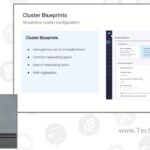|
|

Pooja Ghumre presented for Platform9 at CFD21 |
This video is part of the appearance, “Platform9 Presents at Cloud Field Day 21“. It was recorded as part of Cloud Field Day 21 at 8:00-10:00 on October 23, 2024.
Watch on YouTube
Watch on Vimeo
Platform9’s Private Cloud Director aims to simplify the private cloud experience for users, particularly those transitioning from public cloud environments. The platform introduces the concept of “cluster blueprints,” which allow administrators to define a common template for managing clusters of hypervisors. These clusters are essentially groups of co-located hosts that share similar networking and hardware configurations. The platform uses KVM as the underlying hypervisor, which is a widely adopted virtualization technology. One of the key features of the platform is its ability to over-provision resources, allowing users to maximize hardware utilization by running more virtual machines than the physical cores available, based on the assumption that not all VMs will use their full resources simultaneously.
The platform also supports advanced day-two operations, such as live migration and high availability, which are crucial for minimizing downtime during maintenance or hardware failures. Live migration allows workloads to be moved between hosts without downtime, while high availability ensures that workloads can be redistributed in case of hardware failure. The platform’s multi-tenancy feature is designed for managed service providers (MSPs) and enterprises, allowing them to create isolated environments for different customers or departments. Each tenant can have its own set of resources, such as virtual machines and networks, while sharing the underlying hardware across the region.
In terms of storage, Platform9 supports a variety of backends, including NFS, NetApp, and Ceph, and allows administrators to configure storage policies based on the needs of specific workloads. The platform also offers flexibility in managing hosts at scale, with features like host aggregates and metadata tagging, which make it easier to filter and manage large numbers of nodes. For large-scale environments, such as those with thousands of nodes spread across multiple regions, the platform provides search and bulk operation capabilities to streamline management tasks. Additionally, the platform integrates with automation tools like Ansible, making it easier to onboard new hosts and scale the infrastructure efficiently.
Personnel: Pooja Ghumre








